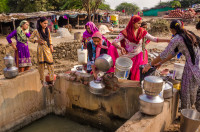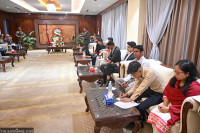Opinion
Reaching every child
Recently, as I was out and about in Kathmandu, I noticed several children asking for money from complete strangers—a sight that locals consider quite common in the streets of Nepal’s Capital.
Recently, as I was out and about in Kathmandu, I noticed several children asking for money from complete strangers—a sight that locals consider quite common in the streets of Nepal’s Capital. It was in the middle of a school day and the first thought that struck me was that these kids ought to be in a classroom. My mind started wandering—about the possible factors that must have compelled them to beg, the obvious lack of health, education, protection, the not so bright-looking future that awaits them, and the fact that their children might be born with an even bleaker future.
Underlying causes
Millions of children in South Asia face a difficult journey through life without school, nutrition and decent health care. For many, this journey starts from the first few days of their life; last year in South Asia, approximately one million babies did not survive their first month.
The problem of babies dying does not always start with poor quality health care, or lack of a skilled birth attendant, although those are indeed real and massive problems. It starts instead with mothers who were born in poverty, were out of school themselves, were married as a child, were undernourished during pregnancy, and who ended up delivering their child in a health centre where the staff were underskilled and overworked. When these factors are combined, the risks to survival for a newborn are extremely high.
Thankfully, we know what health-related changes are needed to save newborn lives—ensuring delivery in a health care facility, having a skilled attendant at birth and never letting up on the need to breastfeed from birth and exclusively through the first six months. There are other evidence-based and relatively inexpensive but critical interventions. Take chlorhexidine for example. Applying this simple antiseptic to the umbilical cord stump prevents infections and saves lives as do many other steps in the journey of care, from pregnancy, to the critical time around birth, and the initial days afterwards.
Joining hands
Despite the alarming number of newborn deaths every year, there has been tremendous progress in South Asia. The number has halved since 1990, but there is still much to do. The Sustainable Development Goals set a very high bar for reducing newborn deaths, and countries in South Asia will not achieve this target unless we all put our efforts into doing more. This means allocating more domestic resources to health, training more doctors and nurses and finding ways to incentivise them to work in the most deprived areas of their country, and securing government’s commitment.
In all this, we must also not forget ‘the causes of the causes’, poverty and lack of education, that result in children spending their days on the street instead of in school.
What can stop the vicious cycle of generational poverty these children and their children are trapped in? Every child has the right to survive and thrive but for this we need to think bigger than just hospitals and doctors. Transformation has wide ranging determinants.
We need to improve all aspects of a child’s life to give them the best chance to lead a healthy and productive life. We need to join hands in reaching every child no matter what their circumstances are or where they live. That’s what reaching every child really means.
Noble is the regional health adviser of Unicef South Asia




 20.12°C Kathmandu
20.12°C Kathmandu









